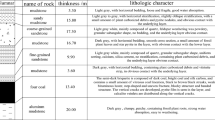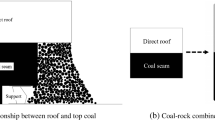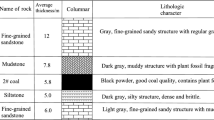Abstract
Low recovery of longwall top coal caving (LTCC) remains one of the most difficult engineering problems in this mining method and impedes its application. The top coal left in the gob at face end accounts for a large portion of the total coal loss, and the instability of the leftover triangle coal at face end has long been a threat to the safety of miners and the mining equipment. In this paper, based on the engineering background of Ruilong mine, we explore the stability of the roof at the end of the face by using theoretical analysis, numerical simulation, and field measurement. Results reveal that in the inclined longwall top coal caving face, the immediate roof forms an “arch” structure, and the basic roof forms a “masonry beam” structure after the roof collapses; working resistance of the support calculated by the method of ultimate bearing capacity was adequate to meet the requirement of roof load; roof load of coal pillar was related to the length of key block and fracture position; and increasing the size of coal pillar could ensure the stability of both coal pillar and roof.










Similar content being viewed by others
References
Bai YR, Bai SW, Jin ZM, Song XM (2001) Testing study of similar material for layer-divided top coal caving in specially thick coal seam. Chin J Rock Mech Eng 20(3):365–369
Basarir H, Oge IF, Aydin O (2015) Prediction of the stresses around main and tailgates during top coal caving by 3D numerical analysis. Int J Rock Mech Min Sci :88–9776
Jeromel G, Medved M, Likar J (2010) An analysis of the geomechanical processes in coal mining using the Velenje mining method. Acta Geotech Slov 7:31–45
Jiang FX (1990) Similar material simulation research of sublevel caving with props in longwall faces. Journal of Shandong Mining Institute 9(4):339–342
Karekal S, Das R, Mosse L, Cleary PW (2011) Application of a mesh-free continuum method for simulation of rock caving processes. Int J Rock Mech Min Sci 48(5):703–711
Khanal M, Adhikary D, Balusu R (2014) Prefeasibility study—geotechnical studies for introducing longwall top coal caving in Indian mines. J Min Sci 50:719–732
Likar J, Medved M, Lenart M (2012) Analysis of geomechanical changes in hanging wall caused by longwall multi top caving in coal mining. J Min Sci 48:135–145
Nan H, Wen YM, Zhou Y (2002) The effect of the parameters of fully mechanized sub-level caving mining shield on the extraction of caving. Journal of Jiaozuo Institute of Technology (Natural Science) 21(6):405–409
Si G, Jamnikar SJ (2015) Monitoring and modeling of gas dynamics in multi-level longwall top coal caving of ultra-thick coal seams. PartI:bore hole measurements and a conceptual model for gas emission zones Int J Coal Geol 144:98–110
Unver B, Yasitli NE (2006) Modelling of strata movement with a special reference to caving mechanism in thick seam coal mining. Int J Coal Geol 66:227–252
Vakili A, Hebblewhite BK (2010) A new cavability assessment criterion for longwall top coal caving. Int J Rock Mech Min Sci 47(8):1317–1329
Wang JC (2009). The theory and technique on the thick coal seam mining. Beijing, China: Metallurgical Industry Press.
Wang SH, Ren FY, Wei YJ, Li WZ (2003) Experimental physical simulation of mineral moving. Journal of Northeastern University (Natural Science) 24(7):699–702
Wang JC, Li ZG, Chen YJ, Zheng HF (2004) The experimental study of loose medium flow field on the longwall top coal caving. J China Coal Soc 29(3):260–263
Wang JC, Yang JL, Liu HH, Zhao DP, Zheng LY (2010) The practical observation research on loose medium flow field theory on the top coal caving. J China Coal Soc 35(3):353–361
Wang JC, Wei LK, Zhang JW, Li ZL (2013) 3D numerical simulation on the top coal movement law under caving mining technique. J China Coal Soc 38(1):1905–1911
Wang JC, Yang SL, Li Y, Wei LK, Liu HH (2014) Caving mechanisms of loose top coal in longwall top coal caving mining method. Int J Rock Mech Min Sci 71(10):160–170
Wu J, Zhang Y (2001) The new concept of relationship between shield and surrounding rock in longwall top coal caving faces. J China Coal Soc 26(4):350–355
Yan SH, Mao DB, Fan SG (2002) The theory and its application of determining working resistance of powered shield in longwall with top coal caving technology. J China Coal Soc 27(1):64–71
Acknowledgements
We acknowledge the financial support from the Guizhou University Talent Research Fund (No. 2016-55) and the National Natural Science Foundation of General Program (No. 51574244), (No. 51574093), and (No. 51264004).
Author information
Authors and Affiliations
Corresponding author
Rights and permissions
About this article
Cite this article
Kong, Dz., Jiang, W., Chen, Y. et al. Study of roof stability of the end of working face in upward longwall top coal. Arab J Geosci 10, 185 (2017). https://doi.org/10.1007/s12517-017-2978-0
Received:
Accepted:
Published:
DOI: https://doi.org/10.1007/s12517-017-2978-0




